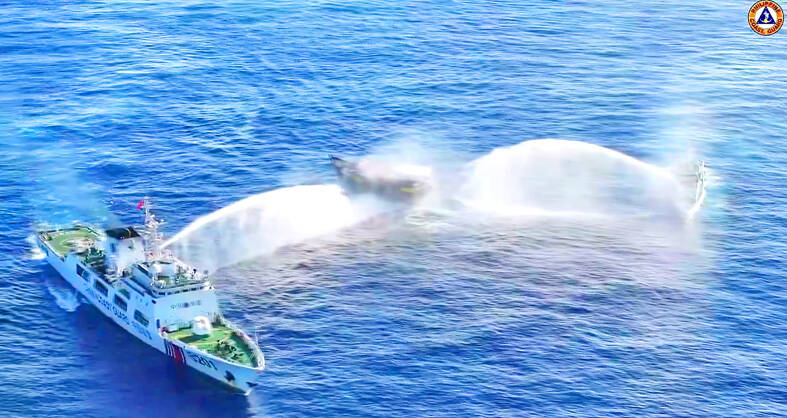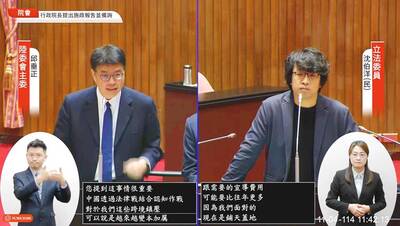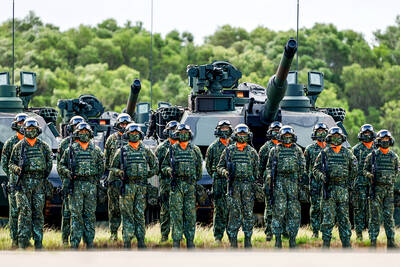Chinese and Philippine coast guard vessels yesterday collided in the disputed South China Sea and four Filipino crewmembers were injured in high-seas confrontations.
The China Coast Guard ships and accompanying vessels blocked the Philippine Coast Guard and supply vessels off the disputed Second Thomas Shoal (Renai Shoal, 仁愛暗沙) and executed dangerous maneuvers that caused two minor collisions between the Chinese ships and two of the Philippine vessels, Philippine officials said.
The BRP Sindangan of the Philippine Coast Guard had minor structural damage from the collision that happened shortly after dawn. Over an hour later, another Chinese coast guard ship first blocked then collided with a supply boat the Philippine coast guard was escorting, the Philippine officials said.

Photo: AFP / Philippine Coast Guard
The supply boat, crewed by Filipino navy personnel, was later hit by water cannon blasts from two Chinese coast guard ships. Its windshield shattered, injuring at least four Filipino crewmembers, a statement from the Philippine government task force dealing with territorial disputes said.
The actions by the Chinese was “another attempt to illegally impede or obstruct a routine resupply and rotation mission,” the task force said.
“China’s latest unprovoked acts of coercion and dangerous maneuvers” against Philippine ships en route to deliver supplies and fresh troops to the Philippine-occupied shoal “put the lives of our people at risk and caused actual injury to Filipinos,” it said.
The Philippine Department of Foreign Affairs summoned China’s deputy ambassador to convey a protest against the China Coast Guard’s actions, which it said were unacceptable.
“The Philippines demands that Chinese vessels leave the vicinity of Ayungin Shoal immediately,” the department said in a statement, using the Philippine name for the contested shoal.
A small Philippine marine and navy contingent has kept watch onboard a rusting warship, the BRP Sierra Madre, which has been marooned since the late 1990s in the shallows of the Second Thomas Shoal.
China also claims the shoal lying off the western Philippines and has surrounded the atoll with coast guard, navy and other ships to press its claims and prevent Filipino forces from delivering construction materials to fortify the Sierra Madre in a decades-long standoff.
The shoal was the site of several tense skirmishes between Chinese and Philippine coast guard ships last year.
The Chinese coast guard said in a statement that “it took control measures in accordance with the law against Philippine ships that illegally intruded into the waters adjacent to Renai Reef,” the name Beijing uses for Second Thomas Shoal.
A Chinese coast guard spokesperson said a Philippine ship deliberately rammed a Chinese coast guard vessel, causing a minor scratch.
Washington strongly condemned the Chinese coast guard’s actions and US Ambassador to the Philippines MaryKay Carlson said that the US stands with the Philippines and proponents of international law.
Australia and Japan separately expressed their concern over China’s actions.

CALL FOR SUPPORT: President William Lai called on lawmakers across party lines to ensure the livelihood of Taiwanese and that national security is protected President William Lai (賴清德) yesterday called for bipartisan support for Taiwan’s investment in self-defense capabilities at the christening and launch of two coast guard vessels at CSBC Corp, Taiwan’s (台灣國際造船) shipyard in Kaohsiung. The Taipei (台北) is the fourth and final ship of the Chiayi-class offshore patrol vessels, and the Siraya (西拉雅) is the Coast Guard Administration’s (CGA) first-ever ocean patrol vessel, the government said. The Taipei is the fourth and final ship of the Chiayi-class offshore patrol vessels with a displacement of about 4,000 tonnes, Lai said. This ship class was ordered as a result of former president Tsai Ing-wen’s (蔡英文) 2018

‘SECRETS’: While saying China would not attack during his presidency, Donald Trump declined to say how Washington would respond if Beijing were to take military action US President Donald Trump said that China would not take military action against Taiwan while he is president, as the Chinese leaders “know the consequences.” Trump made the statement during an interview on CBS’ 60 Minutes program that aired on Sunday, a few days after his meeting with Chinese President Xi Jinping (習近平) in South Korea. “He [Xi] has openly said, and his people have openly said at meetings, ‘we would never do anything while President Trump is president,’ because they know the consequences,” Trump said in the interview. However, he repeatedly declined to say exactly how Washington would respond in

WARFARE: All sectors of society should recognize, unite, and collectively resist and condemn Beijing’s cross-border suppression, MAC Minister Chiu Chui-cheng said The number of Taiwanese detained because of legal affairs by Chinese authorities has tripled this year, as Beijing intensified its intimidation and division of Taiwanese by combining lawfare and cognitive warfare, the Mainland Affairs Council (MAC) said yesterday. MAC Minister Chiu Chui-cheng (邱垂正) made the statement in response to questions by Democratic Progressive Party (DPP) Legislator Puma Shen (沈柏洋) about the government’s response to counter Chinese public opinion warfare, lawfare and psychological warfare. Shen said he is also being investigated by China for promoting “Taiwanese independence.” He was referring to a report published on Tuesday last week by China’s state-run Xinhua news agency,

‘NOT SUBORDINATE’: Only Taiwanese can decide the nation’s future, and people preserving their democratic way of life is not a provocation, President William Lai said Taiwan does not want China’s “one country, two systems,” and must uphold its freedom and democracy as well as resolve to defend itself, President William Lai (賴清德) said yesterday, rejecting Beijing’s latest bid to bring the country under Chinese control. The president made the remarks while attending a commissioning ceremony for Taiwan’s first battalion of M1A2T Abrams tanks in Hsinchu County’s Hukou Township (湖口). The tanks are made by General Dynamics, a major US defense contractor. China this week said it “absolutely will not” rule out using force over Taiwan, striking a much tougher tone than a series of articles in state media